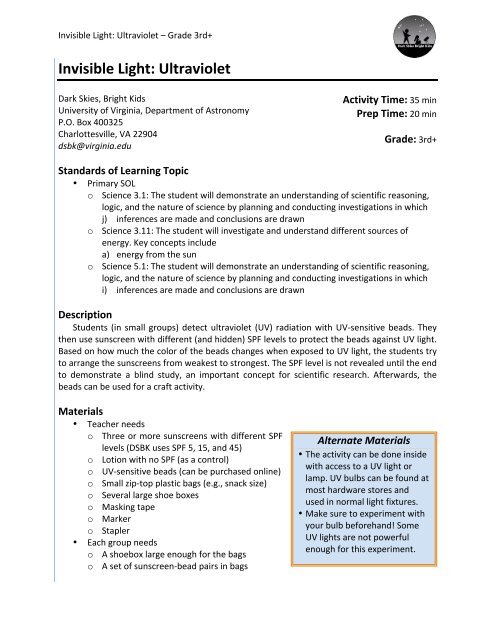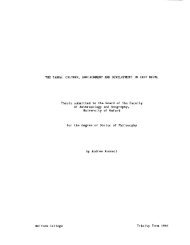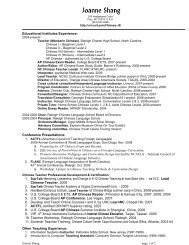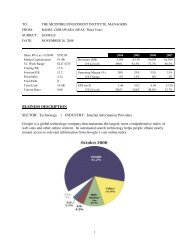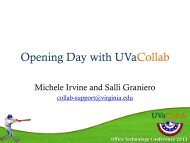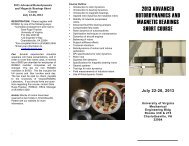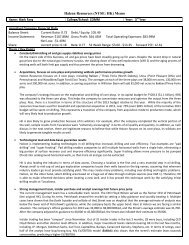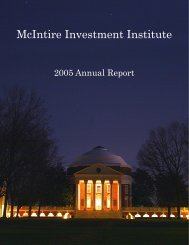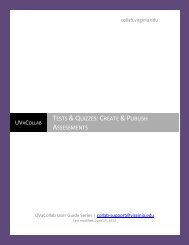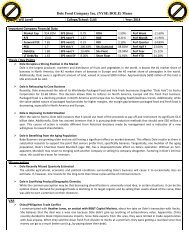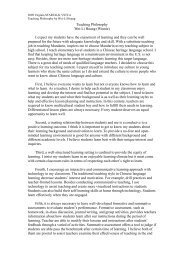Invisible Light: Ultraviolet - University of Virginia
Invisible Light: Ultraviolet - University of Virginia
Invisible Light: Ultraviolet - University of Virginia
You also want an ePaper? Increase the reach of your titles
YUMPU automatically turns print PDFs into web optimized ePapers that Google loves.
<strong>Invisible</strong> <strong>Light</strong>: <strong>Ultraviolet</strong> – Grade 3rd+ <br />
<strong>Invisible</strong> <strong>Light</strong>: <strong>Ultraviolet</strong> <br />
<br />
Dark Skies, Bright Kids <br />
<strong>University</strong> <strong>of</strong> <strong>Virginia</strong>, Department <strong>of</strong> Astronomy <br />
P.O. Box 400325 <br />
Charlottesville, VA 22904 <br />
dsbk@virginia.edu <br />
<br />
Activity Time: 35 min <br />
Prep Time: 20 min <br />
Grade: 3rd+ <br />
<br />
Standards <strong>of</strong> Learning Topic <br />
• Primary SOL <br />
o Science 3.1: The student will demonstrate an understanding <strong>of</strong> scientific reasoning, <br />
logic, and the nature <strong>of</strong> science by planning and conducting investigations in which <br />
j) inferences are made and conclusions are drawn <br />
o Science 3.11: The student will investigate and understand different sources <strong>of</strong> <br />
energy. Key concepts include <br />
a) energy from the sun <br />
o Science 5.1: The student will demonstrate an understanding <strong>of</strong> scientific reasoning, <br />
logic, and the nature <strong>of</strong> science by planning and conducting investigations in which <br />
i) inferences are made and conclusions are drawn <br />
<br />
Description <br />
Students (in small groups) detect ultraviolet (UV) radiation with UV‐sensitive beads. They <br />
then use sunscreen with different (and hidden) SPF levels to protect the beads against UV light. <br />
Based on how much the color <strong>of</strong> the beads changes when exposed to UV light, the students try <br />
to arrange the sunscreens from weakest to strongest. The SPF level is not revealed until the end <br />
to demonstrate a blind study, an important concept for scientific research. Afterwards, the <br />
beads can be used for a craft activity. <br />
<br />
Materials <br />
• Teacher needs <br />
o Three or more sunscreens with different SPF <br />
levels (DSBK uses SPF 5, 15, and 45) <br />
o Lotion with no SPF (as a control) <br />
o UV‐sensitive beads (can be purchased online) <br />
o Small zip‐top plastic bags (e.g., snack size) <br />
o Several large shoe boxes <br />
o Masking tape <br />
o Marker <br />
o Stapler <br />
• Each group needs <br />
o A shoebox large enough for the bags <br />
o A set <strong>of</strong> sunscreen‐bead pairs in bags <br />
Alternate Materials <br />
• The activity can be done inside <br />
with access to a UV light or <br />
lamp. UV bulbs can be found at <br />
most hardware stores and <br />
used in normal light fixtures. <br />
• Make sure to experiment with <br />
your bulb beforehand! Some <br />
UV lights are not powerful <br />
enough for this experiment.
<strong>Invisible</strong> <strong>Light</strong>: <strong>Ultraviolet</strong> – Grade 3rd+ <br />
<br />
Goals <br />
• Illustrate differences between visible and ultraviolet light <br />
• Demonstrate the effectiveness <strong>of</strong> different SPF levels at blocking UV light <br />
• Demonstrate a blind scientific experiment <br />
<br />
Introduction to Topic <br />
The electromagnetic spectrum contains many types <br />
<strong>of</strong> light, most <strong>of</strong> which we cannot detect with our eyes. <br />
The major regions <strong>of</strong> the electromagnetic spectrum <br />
include: gamma rays, X‐rays, ultraviolet, visible, infrared, <br />
microwave, and radio. <strong>Light</strong> can be described by its <br />
energy, wavelength, or frequency. Higher energy light <br />
has smaller wavelengths and higher frequencies (gamma <br />
rays), whereas lower energy light has longer <br />
wavelengths and lower frequencies (radio). <br />
<br />
Pre‐Activity Instruction <br />
The objective <strong>of</strong> this activity is to demonstrate that <br />
there is light that we cannot see with our eyes but that <br />
affects us on a daily basis. <br />
The Sun emits light at all wavelengths, from highenergy <br />
gamma rays to low energy radio waves. Short <br />
wavelength UV rays are harmful to humans and cause <br />
sunburns. Sunscreen can protect us from these UV rays, <br />
and its degree <strong>of</strong> protection is known as the sun protection factor (SPF). <br />
Pro Tips <br />
• About 80% <strong>of</strong> UV light can <br />
penetrate clouds, so this will <br />
work on a cloudy day. <br />
• The beads can change color <br />
about 50,000 times before <br />
they no longer work. <br />
• For a “double blind” study the <br />
person leading the activity <br />
should not fill the lotion bags <br />
so that they will be unaware <strong>of</strong> <br />
the SPF with the students. <br />
• The sunscreen bags can be <br />
used multiple times, though <br />
after a large number <strong>of</strong> <br />
experiments the sunscreen will <br />
begin to lose its effectiveness. <br />
Discuss with the students what they expect from the different types <strong>of</strong> sunscreens and how <br />
to measure their effectiveness using the beads. <br />
<br />
Preparation <br />
1) Fill a plastic bag with each sunscreen or lotion to make a thin layer when spread evenly <br />
throughout the closed bag. Also, include an empty bag as an example <strong>of</strong> no <br />
sunscreen/lotion. You will make one bag for each sunscreen or lotion for each group. <br />
2) Cover the SPF level on the bottles with masking tape (to conceal it for the experiment). <br />
Assign a letter to each bottle and label the bags with their corresponding letter. <br />
3) Make a bag <strong>of</strong> UV beads for each lotion, sunscreen, and a bag to have no lotion. <br />
4) Staple each sunscreen/lotion bag to a bag <strong>of</strong> beads above the zip‐top so that the bag’s <br />
letter is visible. Do the same for an empty bag. Make as many sets as you need. Each <br />
group will need a bag <strong>of</strong> each type. <br />
<br />
Procedure <br />
1) Demonstrate how the UV beads work by exposing them to UV light. Have the students <br />
describe what the beads look like before and after they have been exposed to UV light.
<strong>Invisible</strong> <strong>Light</strong>: <strong>Ultraviolet</strong> – Grade 3rd+ <br />
2) Give each group a set <strong>of</strong> the lotion‐bead pairs. Explain that the SPF <strong>of</strong> each sunscreen is <br />
unknown, and they have to rank them from weakest to strongest. Ask them to <br />
brainstorm how to determine this using the materials they have. <br />
3) Have each group place their bags lotion side up in a shoebox lid. Cover lid with the main <br />
part <strong>of</strong> the box so that when you are holding the box, it appears upside down. <br />
4) Bring the boxes to the UV light source and open them at the same time. If outside, make <br />
sure they are in a sunny spot and make sure the students do not try to look at their <br />
beads in the Sun! On a very sunny day, the beads can reach their full color in only a few <br />
seconds. <br />
5) Watch the bag with no sunscreen or lotion. When those beads have reached their most <br />
intense color, move the boxes away from the UV source and uncover the beads. Have <br />
the students rank the sunscreen bags from least to most effective based on the color <strong>of</strong> <br />
each set <strong>of</strong> beads. Match each bottle <strong>of</strong> sunscreen to one <strong>of</strong> the bags. Peel <strong>of</strong>f the <br />
masking tape to reveal the SPF for each one. <br />
<br />
Post‐Activity Discussion <br />
• Does the amount <strong>of</strong> visible light determine whether you will need sunscreen? <br />
Point out that the beads show no change when under indoor lighting, but (if <br />
possible) demonstrate that the beads will change color in a cloudy condition (or if <br />
sunlight is only partially obscured, by a thin t‐shirt or a window). Thus, being able to <br />
see one type <strong>of</strong> light does not mean you will or will not be exposed to a type <strong>of</strong> light <br />
you cannot see. <br />
This helps to demonstrate that UV light penetrates cloud cover. To further <br />
demonstrate this concept, students can test if windows shield from UV rays. Does <br />
this mean you can get a sunburn inside? <br />
Similarly, while outside students can cover the UV beads with their own clothing to <br />
see whether it is effective at blocking UV light. What types <strong>of</strong> clothing block UV rays? <br />
Can you get a sunburn through your shirt? <br />
• Does the ordering <strong>of</strong> sunscreens match your expectations? <br />
We found that the ordering was generally correct. It is <strong>of</strong>ten difficult to tell the <br />
difference between two bags if the SPFs are close in range. You may explain that SPF <br />
15 lets 7% <strong>of</strong> UV radiation through to skin (when applied perfectly), while SPF 30 <br />
allows 4% through, and SPF 60 allows 2%. So the differences are slight even as the <br />
numbers get large. Sunscreens with low SPFs are probably difficult to distinguish <br />
from your control. <br />
• Why did we have the labels covered during the experiment? <br />
The students determined which sunscreen was the strongest based on the colors <strong>of</strong> <br />
the beads. Had they known which sunscreen had which SPF, their decisions may <br />
have been influenced, especially when it was a close call. By covering the labels, the <br />
students conducted a blind study, which prevented their results from being <br />
prejudiced by prior information. <br />
<br />
Extensions and Related Activities
<strong>Invisible</strong> <strong>Light</strong>: <strong>Ultraviolet</strong> – Grade 3rd+ <br />
• The beads can be used to make jewelry or keychains. Bring additional beads, strong <br />
cord, clasps, earrings, keychain ends, etc. Stations may be helpful for keeping the <br />
activity ordered. Have an earring station manned by a volunteer, a bracelet station, a <br />
keychain station, etc. A UV lamp or light bulb is useful for this as well so that students <br />
can see what their pieces will look like outside! <br />
<br />
Resources <br />
• Sunscreen Test: a similar experiment to ours <br />
www.stevespanglerscience.com/experiment/uv‐reactive‐beads <br />
• The Great Sunscreen Cover Up: all you ever wanted to know about sunscreen <br />
www.sciencebasedmedicine.org/?p=5541 <br />
• The chemistry <strong>of</strong> UV sensitive beads <br />
www.arborsci.com/media/datasheet/P3‐6500_DS.pdf <br />
<br />
Glossary <br />
• Electromagnetic Spectrum – All the different wavelengths <strong>of</strong> light, from gamma ray to <br />
radio. <br />
• Sun Protection Factor (SPF) – A measure <strong>of</strong> the ability <strong>of</strong> a compound or material to <br />
block UV radiation. <br />
• Visible <strong>Light</strong> – The wavelengths <strong>of</strong> light to which our eyes are sensitive. <br />
• Visible Spectrum – The distribution <strong>of</strong> colors visible to the human eye seen when light is <br />
dispersed by a prism. <br />
• <strong>Ultraviolet</strong> (UV) <strong>Light</strong> – <strong>Light</strong> whose wavelength is shorter than visible light but longer <br />
than X‐rays. <br />
• Wavelength – The distance between two successive points in a wave with the same <br />
phase <strong>of</strong> oscillation. <br />


